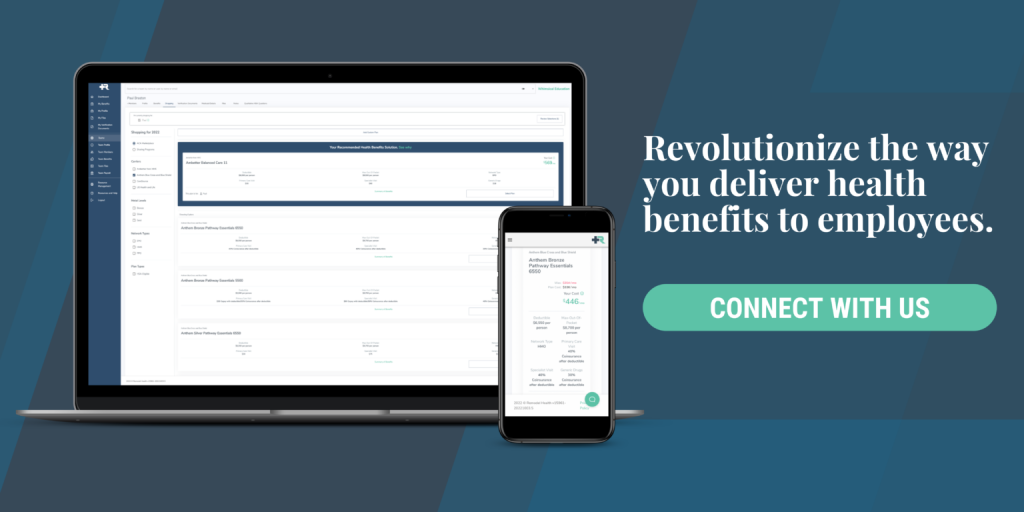
Offering robust healthcare benefits often feels like walking a tightrope between employee satisfaction and budget management. What if there was a way to blend flexibility, tax advantages, and employee empowerment into one seamless solution?
Using ICHRA with HSA achieves precisely that. This combination allows employers to reimburse health insurance premiums while giving employees the ability to save pre-tax dollars for medical expenses. It’s a win-win for balancing organizational cost control with meaningful health benefits.
In this blog post, we’ll dive into how these programs work together, the steps for setting up an HSA-compatible ICHRA, and strategies to overcome common challenges.
Comparing ICHRA and HSA
Individual Coverage Health Reimbursement Arrangements (ICHRAs) and Health Savings Accounts (HSAs) are both powerful tools for managing healthcare expenses. While they share some similarities, their key differences can impact how employers and employees use them together.
The table below highlights the main features of ICHRA and HSA.
| Feature | ICHRA | HSA |
| Contribution Limits | Determined by the employer with no IRS-imposed cap | IRS-set annual limits: $4,300 (individual) and $8,550 (family) in 2025 |
| Eligibility | Requires individual health insurance coverage | Must pair with a high-deductible health plan (HDHP) |
| Ownership | Employer-sponsored, funds stay with the employer | Employee-owned, funds remain with the individual |
| Expense Coverage | Covers premiums and eligible medical expenses | Covers qualified medical expenses but not premiums |
Can ICHRA and HSA Work Together?
Yes, ICHRA and HSA can work together, but there are specific IRS regulations to follow. To maintain HSA eligibility, employees must be enrolled in an HDHP and cannot receive reimbursements for out-of-pocket medical expenses through ICHRA. This type of arrangement is referred to as a “premium-only ICHRA.” The ICHRA must reimburse only for individual health insurance premiums, not for any non-premium medical costs, such as copays or prescriptions.
Additionally, employers offering ICHRA must ensure the HDHP meets the minimum deductible requirements set by the IRS. So it’s important to stay updated on the latest regulations. Employees also need to confirm that their chosen HDHP is compatible with HSA contributions.
Following these rules ensures that employees can maintain their HSA eligibility while benefiting from the flexibility and support of ICHRA, creating a compliant and efficient healthcare benefit strategy.
Combining ICHRA and HSA provides several benefits. Employees gain flexibility in managing their healthcare costs. ICHRAs cover premiums, while HSAs allow tax-advantaged savings for out-of-pocket expenses. Employers benefit by offering a comprehensive, cost-effective health benefits package that supports diverse employee needs.
This pairing empowers employees to save for future healthcare needs while enjoying the immediate benefit of covered premiums. It’s a win-win strategy for modern health benefits.
How to Set Up an ICHRA to be HSA-Compatible

- Define the ICHRA Scope: Offer a “premium-only ICHRA” that reimburses employees exclusively for individual health insurance premiums. Avoid reimbursing out-of-pocket expenses to maintain HSA eligibility.
- Verify HDHP Requirements: Ensure that employees are enrolled in a high-deductible health plan that meets IRS-defined minimum deductible requirements for HSA contributions.
- Establish Reimbursement Limits: Set clear, tax-free reimbursement limits for health insurance premiums. Align these limits with your organization’s budget and contribution strategies.
- Communicate Eligibility Criteria: Clearly outline eligibility rules, including the requirement for HDHP enrollment, and provide guidance on selecting compatible plans through the health insurance marketplace.
- Create a Transparent Process: Develop a simple submission and documentation process for premium reimbursements. Use tools to track claims and ensure compliance.
Best Practices
When setting up an HSA-compatible ICHRA, prioritize clear communication with employees. Provide resources to help them navigate HDHP options and HSA contributions effectively. Regularly review reimbursement and contribution strategies to ensure alignment with both organizational goals and employee needs. By focusing on these best practices, you’ll create a seamless and impactful benefits program.
Learn more about how Remodel Health’s ICHRA+® can benefit your organization
Common Challenges and Solutions
Implementing an ICHRA alongside an HSA offers great benefits, but challenges can arise. Here are some common obstacles and practical solutions to overcome them.
Navigating Compliance Requirements
Maintaining compliance with IRS regulations can be overwhelming, especially with changing guidelines. Employers must ensure their ICHRA meets rules for HSA compatibility and ACA standards.
Solution: Work with legal and tax advisors to stay updated on regulations. Use compliance software to track eligibility and reimbursement limits, reducing the risk of errors.
Ensuring Employee Education
Employees may not fully understand how ICHRA and HSA work together. Misunderstanding eligibility criteria or the benefits of HDHPs can lead to underutilization of the program.
Solution: Provide clear resources, FAQs, and regular training sessions to educate employees on HDHPs, HSA contributions, and ICHRA benefits.
Managing Contribution Strategies
Determining reimbursement amounts and balancing them with HSA contribution strategies can be complex. Employers may struggle to align these with their budgets.
Solution: Analyze employee needs and consult financial advisors to create fair and sustainable contribution strategies. Adjust limits as needed to maintain cost control and employee satisfaction.
Employee Enrollment in Compatible Plans
Employees might choose health plans that don’t meet HSA or ICHRA requirements, leading to compliance issues. This can complicate their ability to benefit from both programs.
Solution: Offer guidance during open enrollment. Provide curated plan options that meet HDHP and ICHRA criteria, simplifying the selection process and ensuring compliance.
Maximizing Benefits: Use ICHRA with HSA Effectively
Using ICHRA with HSA provides a powerful way to enhance employee benefits while maintaining budget control. By combining these programs, employers can offer personalized health coverage options, improve satisfaction, and promote financial wellness among their teams.
The key to success lies in thoughtful planning. Align your ICHRA setup with HSA eligibility requirements, maintain clear communication with employees, and regularly review your strategies to ensure compliance and effectiveness. These steps not only simplify the process but also maximize the value of both programs.
If you’re ready to explore how to use ICHRA with HSA, Remodel Health is here to help. Our expertise ensures your benefits program is seamless, impactful, and perfectly tailored to your organization’s goals.

